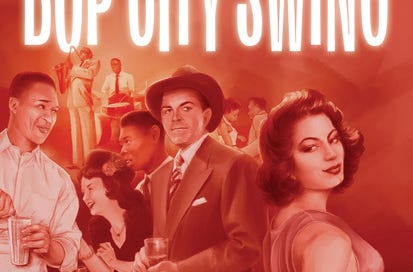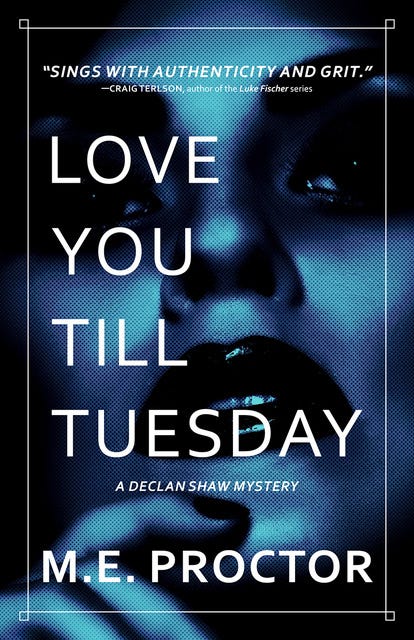Fans of M.E. Proctor and Russell Thayer got a real treat this year with Bop City Swing, a novel that crosses over Proctor’s Tom Keegan and Thayer’s Vivian Davis—a homicide detective and a contract killer, respectively.
But this novel is also a treat for mystery fans who may be new to these characters. Set in 1950s San Francisco, Proctor and Thayer have brought their talents together to weave a whip-smart noir that’s also a ripping good time.
Congratulations on the release of Bop City Swing! How are you feeling?
Thank you. Feeling fine. Even if the writing work has been completed a while ago, seeing the book out there for real always gives me a rush. It’s a bit hectic, of course. Getting the word out. Emails to send, articles to write, asking people to post reviews, organize readings … all the mechanics that surround a book launch. Always too much to do and not enough time to do it. Technology is great to get in touch with people, but it’s also fleeting—meaning you need to repeat the message often, and it’s a balance—too much and you’re a pest, too little and the book vanishes in the information flood. (This is where you can find Bop City Swing, by the way.)
What inspired this story?
Russell Thayer, my co-author, has written over twenty short stories featuring Vivian Davis, aka Gunselle, a contract killer. Her adventures take place between the late ‘30s and the early ‘50s. And I have a recurrent character, Tom Keegan, a San Francisco homicide detective who cracks cases in the 1950s. So far, I’ve written a dozen stories with him as the main protagonist. Last year, Russ and I joked that we should bring the two of them together in a story. Cop and criminal, in the same place at the same time. We kept talking about it, and we finally decided to give it a try.
We weren’t thinking of writing a book. We chatted, exchanged emails. I don’t remember how we came up with a story line revolving around a political assassination. We decided from the start that Gunselle didn’t do it. She would be involved, but we weren’t sure how. We played with a few ideas before landing on the hook: she was hired for the hit but somebody beat her to it. That was the kicker to get the writing ball rolling. It became clear very quickly that we had too much action and too many interesting characters for a short story. Very soon, we were in book territory.
How did you handle the historical details? Was there a round of revision where you did nothing but fact-checking, or was that always baked in?
Because of all the stories we already had on file for the two characters, we both had gathered a gallery of supporting players and reams of documentation on San Francisco in 1950—photographs, newspaper articles, city maps. We chose June 1951, because San Francisco had mayoral elections that year and it was logical that the challenger would launch his campaign in late spring. For the murder scene, the Palace Hotel was convenient. The location downtown wasn’t far from police HQ, and, luckily, we found old hotel floor plans. As the story developed, we included other locations, checked car models, made sure the music tunes were contemporary, and included historical details that anchor and support the plot. We did the research as we went, and as the narrative required. I’m sure we aren’t accurate to the last button, but it’s fiction and plot rules.
How did you and Russell keep a consistent narrative voice throughout the book? Could you tell me more about your collaboration?
Russell wrote the first chapter, from Gunselle’s point of view, then I wrote Tom’s arrival at the crime scene, and we kept alternating the scenes, knowing that at some point we had to bring them face to face and stage a confrontation. We were both familiar with each other’s work and we knew the characters. Luckily, our writing styles do not clash. Russell tends to write short and crisp, while I lean atmospheric. We didn’t worry about the differences because we wrote from the perspectives of our characters, with a style that matched their personalities. We were both comfortable enough with Tom and Gunselle to be able to say ‘he would never do that’ or ‘she would never say that’, and staying in character felt natural.
There were multiple drafts and rewrites, and we tweaked each other’s sections so much that the writing styles started to blend. If there were sharp angles, they got polished off to let the story flow naturally. For a collaboration to work, the authors need to be flexible. You have to be able to accept changes and cuts to your stuff, and admit that not all your ideas will make it to the final manuscript. We had so much fun working on this that we are doing another one. Same characters, different place. And just like Bop City Swing, we’re excited to see where the story goes.
When did you start writing fiction? What attracted you to the crime and mystery genre in particular?
I had short stories published in my mid-twenties, then life intervened, travel, a demanding job I loved. I still wrote on the weekends and produced a four-volume science fiction series that way (The Savage Crown), very, very slowly! The problem was that I didn’t have the time or energy to do the non-writing part of the work: querying, getting my name out there, developing contacts … the legwork, the marketing, the business side that is a lot less fun than hammering at a keyboard and letting loose.
Ten years ago, I decided to go all in and wrestle this writing thing to the ground. Crime fiction is by far my favorite reading genre, always has been. I had just completed the science fiction series and I wanted to sink my teeth in realistic and contemporary fiction. Why not write what I so loved to read? That’s how the character of Declan Shaw, a PI based in Houston, was born. I wrote one book, polished it, and sent it out into the world. While I waited for responses to my queries, I went back to short fiction and submitted those stories. Some were crime, some were SF, horror, or literary. I have over a hundred out there, in a wide variety of publications.
Writing short fiction has been helpful in many ways. First, the more you write, the better you get. Then, getting shorts published helps build relationships, with readers, fellow writers, publishers. And, most importantly, it kept me wanting to keep writing. Love You Till Tuesday, the first Declan Shaw thriller published, is the fourth book I wrote featuring the character. The other three are in my drawers and may never be released. Then, while I worked on the Declan novels, a publisher released a collection of my crime short stories, Family and Other Ailments. And now, Bop City Swing is out before the next Declan that is scheduled for release in September. It’s all a bit topsy-turvy. The publishing world moves in mysterious ways.
What was the most challenging part of writing this book?
For me being true to the period and the characters was all-important. I love noir movies and classic crime fiction. Diving into the 1950s was a pleasure. It felt like I was directing my own movie. The danger was slipping into caricature, or cliché. It was tempting to use hardboiled slang, for instance, or wheel in the tropes of mid-century pulp. Femmes fatales, violent and corrupt cops, back-alley fistfights … you know what I mean. So, I wanted to keep the focus on the people and make sure that their reactions were genuine, that their feelings came across as natural. Bop City Swing is set in 1951, but you could move the plot sixty years in the future and it would still work. Realism wasn’t a challenge, but it’s something I kept in mind all through the process.
I read in your post about Simenon that you were actually born in Brussels. When did you move to the states? Has that family background affected your perspective on American history or culture?
I’ve been living in the U.S. for 28 years, all of them in Texas—in Houston or nearby. One of the benefits of being born in a small country (Belgium is the size of Maryland) is that, both in school, at work, and in the news, you’re exposed to the world. You know what’s going on across the borders, because you can be across the border in less than two hours, driving. Belgium has also been constantly invaded, so history class takes you all over Europe.
I’ve always been interested in American history and the culture is very much international. I didn’t grow up watching all the same TV shows as my husband—he was born in upstate New York—but many of them made it over, same with music and movies. I was less up-to-date on the history of Texas, but since I got there, I’ve been catching up. A friend asked me recently if I had a culture shock when I moved. I didn’t. There are little differences and people love to point them out (milk in cartons instead of plastic, the price of gas, shops closed on Sunday …), but all that isn’t very important. For my stories, I often find inspiration both in Texas and the coast of the North Sea where I spent a lot of time as a kid. I decided to set the crime novel, Love You Till Tuesday, in Houston, because I love the place, and it’s a great location for a detective story.
Where can readers learn more or connect with you?
I’ve been doing my Substack newsletter The Roll Top Desk for 2 ½ years now. It comes out every other Thursday and I enjoy doing the posts. It’s a change of rhythm, no fiction! I share thoughts about writing and reading, and interview one author every quarter. Readers can catch up with news on the books and the short stories. The website has links to the publications that are free to read, and it’s a good place to grab information. I’ve written guest posts for crime/mystery websites and all those are linked on the site. Then there’s social media, of course: X (formerly Twitter), BlueSky, Facebook, and Instagram. I can be found in many places.
M.E. Proctor (www.shawmystery.com) was born in Brussels and lives in Texas. The first book in her Declan Shaw PI series, Love You Till Tuesday (2024), came out from Shotgun Honey, with the follow up, Catch Me on a Blue Day, scheduled for 2025. She’s the author of a short story collection, Family and Other Ailments, and the co-author of a retro-noir novella, Bop City Swing. Her fiction has appeared in Vautrin, Tough, Rock and a Hard Place, Bristol Noir, Mystery Tribune, Shotgun Honey, Reckon Review, and Black Cat Weekly among others. She’s a Derringer nominee.






Thank you for having me in your pages!